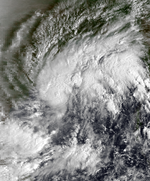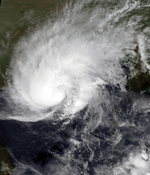1990 North Indian Ocean cyclone season
| 1990 North Indian Ocean cyclone season | |
|---|---|

Season summary map
|
|
| Seasonal boundaries | |
| First system formed | April 18, 1990 |
| Last system dissipated | December 19, 1990 |
| Strongest storm | |
| Name | BOB 01 |
| • Maximum winds | 235 km/h (145 mph) (3-minute sustained) |
| • Lowest pressure | 920 hPa (mbar) |
| Seasonal statistics | |
| Depressions | 10 official, 1 unofficial |
| Deep depressions | 6 |
| Cyclonic storms | 2 |
| Super cyclonic storms | 1 |
| Total fatalities | 967 |
| Total damage | $600 million (1990 USD) |
| Related articles | |
| Super cyclonic storm (IMD) | |
| Category 4 tropical cyclone (SSHWS) | |
| Duration | May 4 – May 10 |
|---|---|
| Peak intensity | 235 km/h (145 mph) (3-min) 912 hPa (mbar) |
| Deep depression (IMD) | |
| Tropical depression (SSHWS) | |
| Duration | October 31 – November 4 |
|---|---|
| Peak intensity | 55 km/h (35 mph) (3-min) 1001 hPa (mbar) |
| Severe cyclonic storm (IMD) | |
| Tropical storm (SSHWS) | |
| Duration | December 14 – December 19 |
|---|---|
| Peak intensity | 100 km/h (65 mph) (3-min) |
The 1990 North Indian Ocean cyclone season featured a below average total of twelve cyclonic disturbances and one of the most intense tropical cyclones in the basin on record. During the season the systems were primarily monitored by the India Meteorological Department, while other warning centres such as the United States Joint Typhoon Warning Center also monitored the area. During the season there was at least 1577 deaths, while the systems caused over US$693 million in damages. The most significant system was the 1990 Andhra Pradesh cyclone, which was the most intense, damaging and deadliest system of the season.
During 1990 a below average total of twelve cyclonic disturbances were recorded during the year, by the India Meteorological Department (IMD) and Joint Typhoon Warning Center (JTWC). This included ten systems in the Bay of Bengal and two systems over the Arabian Sea and Bangladesh. Two of the disturbances developed further over the Bay of Bengal and became cyclonic storms, while for the fifth year in a row there were no cyclonic storms over the Arabian Sea. The first disturbance of the season was briefly monitored by the JTWC between April 18 – 19, before the second system of the season developed over the Bay of Bengal during May 4. The system subsequently intensified further and became the strongest tropical cyclone of the season, before it made landfall in southern Andhra Pradesh during May 9. After the system was last noted on May 11, a land depression was monitored over Bangladesh during May 15, while four other systems including the remnant depression of Typhoon Becky were monitored by the IMD during the monsoon season. After the monsoon had withdrawn from India, two deep depressions and a depression were monitored as they impacted the Bay of Bengal, India and Bangladesh, while a depression was monitored over the Arabian Sea. The second and final Cyclonic Storm of the year developed over the Bay of Bengal and affected Bangladesh and Myanmar (Burma) during December.
The Andhra Pradesh cyclone of May caused considerable damage to properties and was responsible for 967 deaths. However, the cyclone warnings issued by the IMD were greatly appreciated by the Public and Government, as they helped to restrict the death to under 1000 people and prompted the state governments to evacuate a large population from coastal areas. The other cyclonic storm of the year caused some damage to properties and deaths in Bangladesh and Myanmar, while the ten depressions all brought rain to the region with two causing over 200 deaths each. During the year a strong south-west monsoon was observed, which produced heavy rain and lead to flooding in India, Bangladesh and Myanmar.
...
Wikipedia






